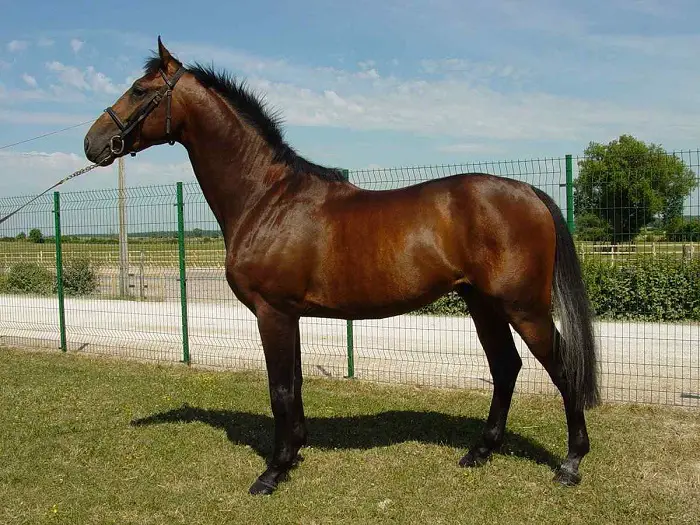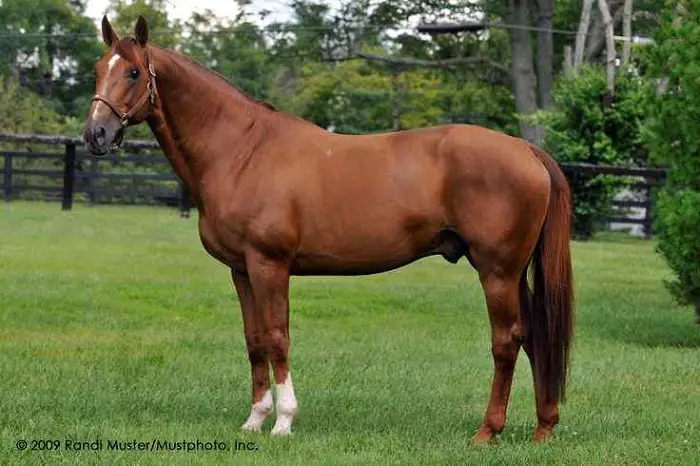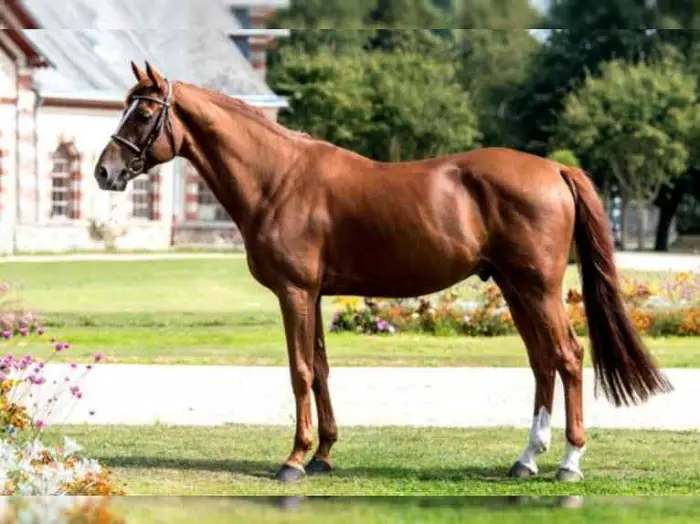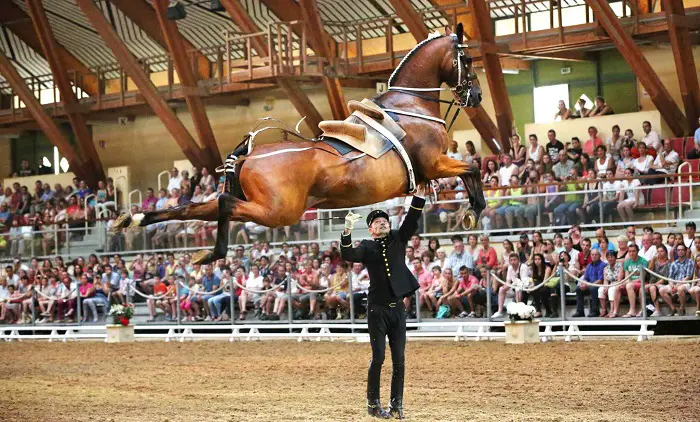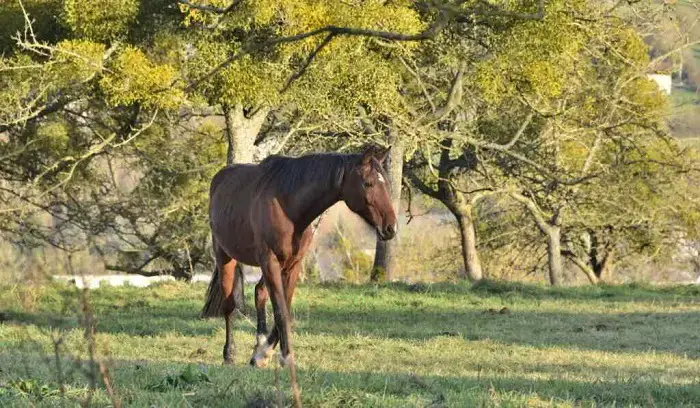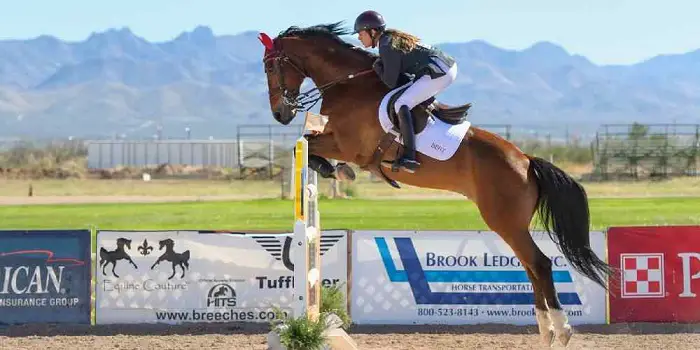The Selle Français is a famous horse breed that originates from France. “Selle Français” translates to “French Saddle Horse” in English. It is primarily bred for show jumping, although it is also successful in other equestrian disciplines such as dressage, eventing, and hunter/jumper classes.
The Selle Français breed was developed by crossing local French mares with Thoroughbred and Anglo-Norman stallions in the mid-19th century. The goal was to create a versatile sport horse with the agility and athleticism needed for show jumping.
French Saddle Horses are known for their elegance, power, and scope over fences. They typically have refined heads, well-muscled bodies, and strong hindquarters. The breed’s conformation enhances its jumping ability and provides balance and agility.
Origin and History of Selle Français Horse
The origin and history of the French Saddle Horse breed can be traced back to the mid-19th century in France. The breed was developed through a crossbreeding program to create a versatile sport horse with exceptional jumping ability. Here is a closer look at the origin and history of the Selle Français horse:
- Foundation and Crossbreeding: The development of the French Saddle Horse began in the 19th century when French breeders sought to improve the local horse stock for military and agricultural purposes. They crossed local French mares, often a mix of draft and riding breeds, with Thoroughbred and Anglo-Norman stallions.
- Influence of Thoroughbred and Anglo-Norman: The infusion of Thoroughbred blood brought the breed speed, endurance, and refinement. Anglo-Norman bloodlines added strength, substance, and jumping ability. This crossbreeding program aimed to produce a horse suitable for both military tasks and civilian sports.
- The Role of the National Studs: The development of the French Saddle horse was heavily influenced by the French national studs, particularly the Le Pin National Stud and the Haras de Saint-Lô. These studs played a vital role in breeding, selecting, and promoting the breed.
- Official Recognition: The breed’s name, “Selle Français,” was officially adopted in the 1950s. The Association Selle Français (ASF) was established in 1960 to manage and promote the breed. The ASF developed breeding standards, maintained a studbook, and organized competitions to showcase the breed’s capabilities.
- Focus on Show Jumping: The breed shifted towards show jumping over time. The breeders began selecting and breeding horses with exceptional jumping ability, athleticism, and rideability. The French Saddle Horse breed became synonymous with successful show jumpers and gained a reputation as a top choice for riders in the discipline.
- International Recognition and Success: Selle Français horses have enjoyed significant success on the international stage, competing in prestigious show jumping events around the world. The breed’s exceptional jumping technique, scope, and agility have made it a favorite among top riders and trainers.
- Modern Selle Français: The modern French Saddle horse results from decades of selective breeding. The breed’s conformation has evolved to optimize its jumping ability, emphasizing power, balance, and athleticism. The breed’s temperament has also been refined to combine sensitivity, intelligence, and a strong work ethic.
Physical Features of Selle Français horses
The Selle Français is a French sport horse breed known for its athleticism and versatility. Here are some of the typical physical features of Selle Français horses:
- Size: French Saddle horses are usually medium to large. They generally stand between 15.3 to 17 hands (155 to 173 cm) tall at the withers, with variations depending on individual horses.
- Body: They have a well-balanced and muscular body with a deep chest and strong hindquarters. Selle Français horses are known for their power and agility.
- Head: The head of a French Saddle Horse is usually expressive, with a straight or slightly convex profile. The eyes are bright and alert, and the ears are well-set and attentive.
- Neck: They have a moderately long and well-arched neck that is muscular and blends smoothly into the shoulders. The neck gives the horse an elegant appearance.
- Legs: French Saddle Horses have strong, well-developed legs with clean, dense bone structures. The cannon bones are usually short and robust, and the pasterns are sloping and flexible. The hooves are generally solid and well-shaped.
- Coat: The coat of a Selle Français can come in various solid colors, including bay, chestnut, gray, and black. Some horses may have white markings on their face or legs.
- Mane and Tail: The mane and tail of a French Saddle Horses are typically thick and flowing. Some individuals may have a long, wavy mane, while others may have a straight and shorter mane.
- Movement: Selle Français horses are known for their powerful and elastic movement. They have good reach and engagement in their gaits, making them well-suited for various equestrian disciplines.
Height and Weight of French Saddle Horse
The height and weight of French Saddle Horses can vary depending on factors such as genetics, individual conformation, and the specific discipline they are bred for. However, I can provide you with some general ranges for height and weight:
Height: Selle Français horses typically range in height from 15.3 to 17 hands (155 to 173 cm) at the withers. Some individuals may fall slightly outside this range, but this is the general height range for the breed.
Weight: The weight of a Selle Français horse can vary based on factors such as age, gender, and overall body condition. Adult Selle Français horses can average weigh between 1,100 to 1,400 pounds (500 to 635 kg). Stallions and more significant individuals may weigh toward the higher end of this range.
Colors and Markings of Selle Français horses
The French Saddle Horse can come in a variety of colors and may exhibit different types of markings. Here are some of the standard colors and markings found in the breed:
- Colors: Bay is a standard color in Selle Français horses. It ranges from a rich, reddish-brown shade to a lighter, tan color with black points (mane, tail, and lower legs).
- Chestnut: Chestnut is another standard color, varying from a deep, reddish-brown to a lighter, golden shade.
- Gray: Gray horses have a coat that lightens over time, often starting with a darker color and gradually turning gray as they age.
- Black: Black-colored Selle Français horses have a solid black coat without any other markings or dilutions.
Markings:
- Star: A star is a slight white marking on the horse’s forehead. It appears as a single patch of white hair.
- Stripe: A stripe, also known as a blaze, is a white marking that extends down the middle of the horse’s face, starting from the forehead and reaching down to the muzzle.
- Snip: A snip is a slight, white marking on the horse’s muzzle. It is typically a narrow strip or spot of white hair.
- Socks and Stockings: Socks refer to white markings that extend up from the hoof onto the lower leg, while stockings extend higher, reaching up to or just below the knee or hock.
- Ermine Spots: Ermine spots are small, black spots with white edges that appear on the horse’s legs, usually just above the hoof. They can be present on any horse color but are more noticeable on lighter coats.
Behavior and Temperament of Selle Français
French Saddle Horses are known for their desirable behavior and temperament traits, contributing to their versatility and suitability for various equestrian disciplines. Here are some key characteristics of their behavior and temperament:
- Willingness to work: French Saddle Horses are generally willing and eager to work. They have a strong work ethic and are known for their willingness to please their riders. This makes them trainable and cooperative partners in various equestrian activities.
- Intelligence: French Saddle Horses are considered intelligent animals. They are quick to learn and can exhibit good problem-solving skills. Their intelligence allows them to understand and respond to cues and aids effectively.
- Sensitivity: French Saddle Horses can be sensitive to their rider’s aids and cues. They tend to be responsive to subtle aids, making them suitable for riders with a light touch and clear communication.
- Athleticism: French Saddle Horses are bred for athleticism and versatility. They possess natural athletic abilities, including strength, agility, and endurance. Their athleticism allows them to excel in various equestrian disciplines, such as show jumping, dressage, and eventing.
- Courage and Confidence: Selle Français horses are often described as brave and confident. They are naturally bold and are known for confidently tackling challenging obstacles, making them well-suited for jumping courses or eventing challenges.
- Temperament: French Saddle Horses generally have a pleasant and amiable temperament. They are known to be friendly and sociable and enjoy human interaction. They often have a calm demeanor, contributing to their suitability as reliable riding partners.
Food and Nutrition of French Saddle Horse
French Saddle Horses, like all horses, require a balanced and appropriate diet to maintain their health and meet their nutritional needs. Here are some critical aspects of the food and nutrition for Selle Français horses:
- Forage: The foundation of a French Saddle Horse’s diet should be high-quality forage, such as grass or hay. Access to pasture grazing or providing free-choice hay is essential for their digestive health. Forage provides necessary fiber and helps maintain proper gastrointestinal function.
- Concentrates: French Saddle Horses may require additional nutrition in concentrates, such as grains or commercial feeds. The specific type and amount of concentrates will depend on the horse’s individual needs, activity level, and body condition. It’s crucial to choose feeds specifically formulated for horses and follow the manufacturer’s feeding guidelines.
- Protein: French Saddle Horses, especially those in training or performance, require adequate protein for muscle development and repair. Good protein sources include legume hay (such as alfalfa) or appropriate protein-rich concentrates. The protein content in the diet should be balanced with other nutrients and tailored to the horse’s requirements.
- Water: The Selle Français horses must always have clean and fresh water. Horses should have free access to water throughout the day and be encouraged to drink regularly.
- Minerals and Vitamins: French Saddle Horses need a balanced supply of essential minerals and vitamins for their health. A good-quality, balanced concentrate or a mineral supplement may be necessary to ensure they receive adequate levels of essential nutrients, such as calcium, phosphorus, magnesium, and vitamins.
- Feeding Routine: Establishing a consistent feeding routine benefits Selle Français horses. Regular feeding times and portion control help maintain a healthy metabolism and digestion. Horses should be fed small meals multiple times daily rather than one or two large meals to mimic their natural grazing behavior.
Care and Management of Selle Français Horse
Proper care and management are crucial for maintaining French Saddle Horses’ health, well-being, and performance. Here are some essential aspects of care and management for Selle Français horses:
- Stable and Environment: Provide a clean, well-ventilated stable shelter that offers protection from extreme weather conditions. The bedding should be comfortable, clean, and regularly maintained. Turnout in a suitable pasture or paddock with safe fencing benefits the horse’s mental and physical well-being.
- Feeding: Ensure a balanced diet with appropriate amounts of forage and concentrates. Feed according to the horse’s needs, and monitor their body condition regularly to make adjustments as necessary. Feed and water should be provided in clean, easily accessible containers.
- Regular Exercise: Selle Français horses are athletic animals that benefit from regular exercise. Develop an exercise program that includes a combination of riding, lunging, and turnout to maintain their physical fitness and mental stimulation. Varying types of exercise, such as flatwork, jumping, and hacking, help prevent boredom and promotes overall fitness.
- Veterinary Care: Schedule regular veterinary check-ups, vaccinations, and dental examinations for your Selle Français horse. Follow appropriate deworming protocols and address any health concerns promptly. Regular hoof care, including trimming and shoeing, is essential for maintaining healthy feet.
- Grooming: Regular grooming promotes a healthy coat, skin, and cleanliness. Brushing or curry-combing the horse’s coat helps remove dirt, debris, and loose hair. Pay attention to cleaning and inspecting the hooves daily to prevent hoof-related issues.
- Socialization and Mental Stimulation: Selle Français horses are social animals and benefit from regular interaction with other horses and humans. Provide opportunities for turnout with compatible companions and engage in activities stimulating their minds, such as training sessions, groundwork, or puzzle toys.
- Safety and Handling: Handle French Saddle Horses with care and respect. When working with them, use proper safety equipment, such as a well-fitted halter, lead rope, and appropriate riding gear. Develop a consistent and respectful handling routine, which includes grooming, tacking up, and handling the horse’s feet.
- Emotional Well-being: Provide a calm and stress-free environment for your Selle Français horse. Minimize exposure to loud noises, excessive commotion, or stressful situations. Allow regular access to pasture or turnout, and consider using enrichment toys or activities to promote mental stimulation and reduce boredom.
Health and Diseases of Selle Français Horse
Selle Français horses, like all horse breeds, are susceptible to specific health issues and diseases. Here are some common health concerns and diseases that can affect Selle Français horses:
- Lameness: Lameness is a common issue in horses and can be caused by various factors, including injuries, joint problems, tendon/ligament issues, or hoof conditions. Regular hoof care, appropriate exercise, and early detection of lameness signs are essential for managing this condition.
- Colic: Colic refers to abdominal pain in horses and can have various causes, such as gastrointestinal blockages, intestinal inflammation, or gas accumulation. Maintaining a consistent feeding and management routine, providing a balanced diet, and monitoring for signs of colic are essential for early detection and treatment.
- Respiratory Conditions: Horses, including Selle Français horses, can develop respiratory issues like allergies, respiratory infections, or recurrent airway obstruction (RAO, also known as heaves). Adequate ventilation, minimizing dust exposure, and good stable management practices help reduce the risk of respiratory problems.
- Equine Metabolic Syndrome (EMS): EMS is a metabolic disorder that can affect horses and is characterized by insulin dysregulation, obesity, and an increased risk of laminitis. Proper diet, exercise, and weight control prevent and manage EMS.
- Cushing’s Disease (PPID): Cushing’s disease, or Pituitary Pars Intermedia Dysfunction (PPID), is a hormonal disorder commonly seen in older horses. It can lead to various symptoms, including abnormal hair growth, weight loss, and increased infection susceptibility. Regular veterinary monitoring and appropriate treatment help manage this condition.
- Skin Conditions: Selle Français horses may be prone to skin conditions such as allergies, dermatitis, or rain rot. Good hygiene practices, regular grooming, and prompt treatment of any skin issues are essential for maintaining skin health.
- Parasites: Horses are susceptible to internal and external parasites, including worms and external pests like ticks and flies. Proper deworming protocols, regular veterinary checks, and effective pest control measures help manage parasite infestations.
What are Selle Français Horses Used For?
French Saddle horses are highly versatile and used for various equestrian disciplines and purposes. Some of the common uses of Selle Français horses include:
- Show Jumping: Selle Français horses are renowned for their show-jumping abilities. They are bred for athleticism, agility, and scope, making them popular choices for show jumping competitions at various levels, from local shows to international events.
- Dressage: Selle Français horses can excel in dressage. Their trainable nature, suppleness, and natural movement make them well-suited for the precise movements and collection required in dressage competitions.
- Eventing: Selle Français horses are often seen participating in eventing, which combines dressage, cross-country, and show jumping. Their athleticism, bravery, and versatility make them suitable for the demands of this three-phase discipline.
- Hunter/Jumper: Selle Français horses are well-suited for the hunter/jumper discipline. Their smooth gaits, natural jumping ability, and calm demeanor make them suitable for hunter classes that emphasize style and consistency. They can also excel in jumper classes due to their agility and scope.
- Cross-Country: Selle Français horses perform well in cross-country riding with their athletic ability and endurance. They can navigate challenging terrain and jump various obstacles found on cross-country courses.
- Pleasure Riding and Trail Riding: Selle Français horses can be enjoyed as leisurely or trail-riding pleasure horses. Their calm temperament, comfortable gaits, and versatility make them enjoyable mounts for recreational riders.
- Breeding: Selle Français horses are also valued for their breeding potential. Their strong bloodlines, athleticism, and desirable traits make them sought after as breeding stock to produce offspring with competitive potential in various disciplines.
How much does a Selle Français horse cost?
The cost of a Selle Français horse can vary widely depending on various factors such as age, training level, pedigree, competition record, and individual characteristics. Additionally, regional and market influences can also affect the price. As of my knowledge cutoff in September 2021, the price range for a Selle Français horse can typically start from a few thousand dollars to tens of thousands or even hundreds of thousands for top-quality, well-trained, and successful competition horses.
Final Talk on French Saddle Horse
Selle Français horses are a remarkable breed known for their athleticism, versatility, and desirable traits. Originating from France, they have gained recognition worldwide for their performance in various equestrian disciplines.
These horses are renowned for their show jumping abilities, with their natural agility, scope, and willingness to jump. They excel in the demanding sport of show jumping and compete at different levels, from local shows to prestigious international events.
In addition to show jumping, French Saddle horses are also successful in dressage, eventing, hunter/jumper competitions, and cross-country riding. Their trainable nature, athleticism, and versatility make them adaptable to different disciplines, making them sought after by riders and professionals alike.
